2018 KIA K900 child seat
[x] Cancel search: child seatPage 4 of 544

ii
1
2
3
4
5 6
7
8 I
IntroductionHow to use this manual / Fuel requirements / Vehicle break-in process /Vehicle data collection and event data recorders
Your vehicle at a glance
Exterior overview / Interior overview / Instrument panel overview / Engine compartment
Seat and safety features of your vehicle
Seats / Seat belts / Child restraint system / Air bag
Features of your vehicleSmart key / Door locks / Trunk / Windows / Hood / Fuel filler lid / Panoramic sunroof / Steering wheel / Mirrors /
Instrument cluster / Lighting / Wipers & Washers / Climate control system / Audio system / Etc.
Driving your vehicleBefore driving / Engine start/stop button / Transmission / Brake system /
Cruise control system / Advanced Smart Cruise Control system / Winter driving / Vehicle load limit / Etc.
What to do in an emergencyRoad warning / Emergency while driving / Emergency starting / Engine overheat / TPMS / Flat tire / Towing / Etc.
MaintenanceEngine compartment / Maintenance service / Engine oil / Engine coolant / Brake flui\
d / Washer fluid / Parking
brake / Air cleaner / Wiper blades / Battery / Tire and wheels / Fuses / Light bulbs / Etc.
Specifications, Consumer information and Reporting safety defects
Index
Table of contents
KH USA FOREWORD:2016 12/28/2016 3:34 PM Page 3
Page 19 of 544
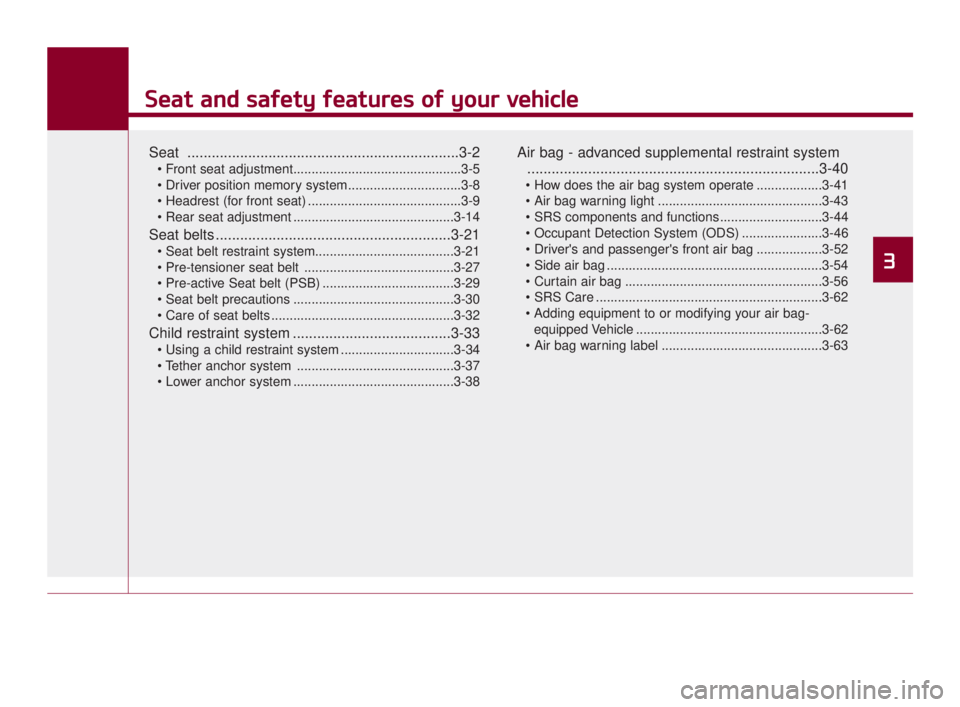
Seat and safety features of your vehicle
3
Seat and safety features of your vehicle
3
Seat and safety features of your vehicle
3
Seat and safety features of your vehicle
Seat ...................................................................\
3-2
..........................................3-9
............................................3-14
Seat belts ..........................................................3-21
.........................................3-27
....................................3-29
............................................3-30
..................................................3-32
Child restraint system .......................................3-33
...............................3-34
...........................................3-37
............................................3-38
Air bag - advanced supplemental restraint system........................................................................\
3-40
..................3-41
.............................................3-43
......................3-46
..................3-52
...........................................................3-54
......................................................3-56
..............................................................3-62
equipped Vehicle ...................................................3-62
............................................3-63
3
KH USA 3:2018 4/18/2017 9:33 AM Page 1
Page 23 of 544
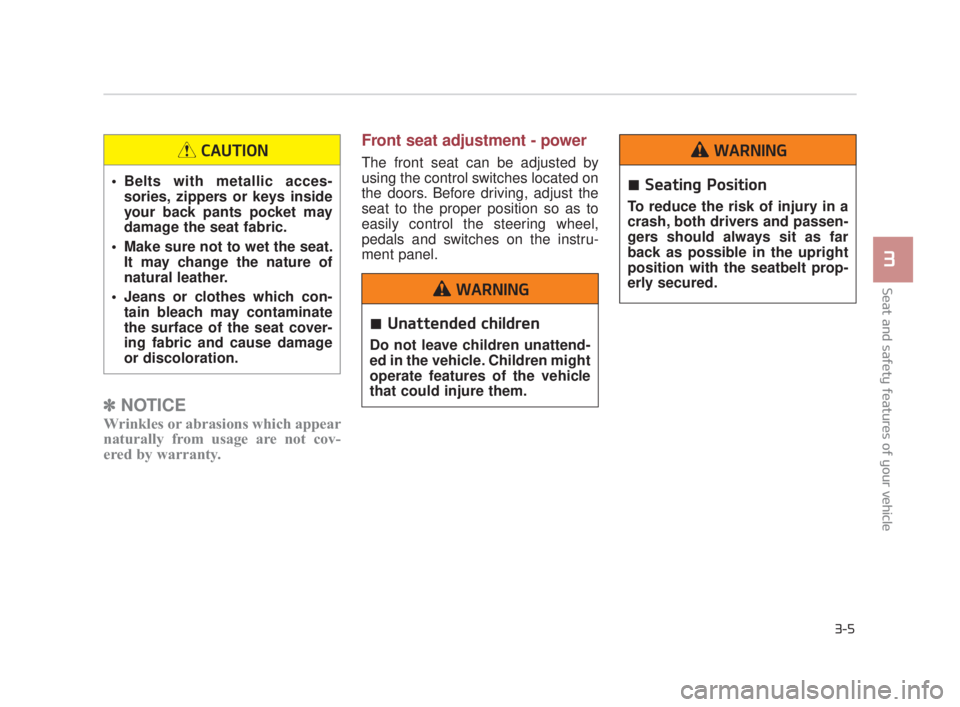
Seat and safety features of your vehicle
3
3-5
✽NOTICE
Wrinkles or abrasions which appear
naturally from usage are not cov-
ered by warranty.
Front seat adjustment - power
The front seat can be adjusted by
using the control switches located on
the doors. Before driving, adjust the
seat to the proper position so as to
easily control the steering wheel,
pedals and switches on the instru-
ment panel.
Unattended children
Do not leave children unattend-
ed in the vehicle. Children might
operate features of the vehicle
that could injure them.
WARNING
Seating Position
To reduce the risk of injury in a
crash, both drivers and passen-
gers should always sit as far
back as possible in the upright
position with the seatbelt prop-
erly secured.
WARNING
Belts with metallic acces-
sories, zippers or keys inside
your back pants pocket may
damage the seat fabric.
Make sure not to wet the seat. It may change the nature of
natural leather.
Jeans or clothes which con- tain bleach may contaminate
the surface of the seat cover-
ing fabric and cause damage
or discoloration.
CAUTION
KH USA 3:2018 4/18/2017 9:34 AM Page 5
Page 32 of 544

3-14
Seat and safety features of your vehicle
Rear seat adjustment
- for power seat (if equipped)
The rear seat can be adjusted by
using the control switches located on
the door.When in operation, the power seat
consumes a large amount of electri-
cal power. To prevent unnecessary
battery drain, don’t adjust the power
seat longer than necessary while the
engine is not running.Seat adjustment
Do not adjust the seat whilewearing seat belts. Moving the
seat forward will cause strong
pressure on the abdomen.
Do not place your hand near the seat when adjusting the
seat. Your hand could get
caught in the seat mecha-
nism.
WARNING
Do not operate the rear power
seat while the child seat is
installed. Operation of the rear
power seats affect the proper
car seat installation and thereby
increase the risk of injury to the
child seat occupant.
WARNING
Power seat adjustments
The power seating controls
function by electronic motor.
Excessive operation may cause
damage to the electrical equip-
ment.
CAUTION
Power Seating
Do not operate two or more
power seat control switches at
the same time. Doing so may
damage the power seat motor
or electrical components.
CAUTION
Unattended children
Do not leave children unattend-
ed in the vehicle. Children might
operate features of the vehicle
that could injure them.
WARNING
KH USA 3:2018 4/18/2017 9:34 AM Page 14
Page 39 of 544
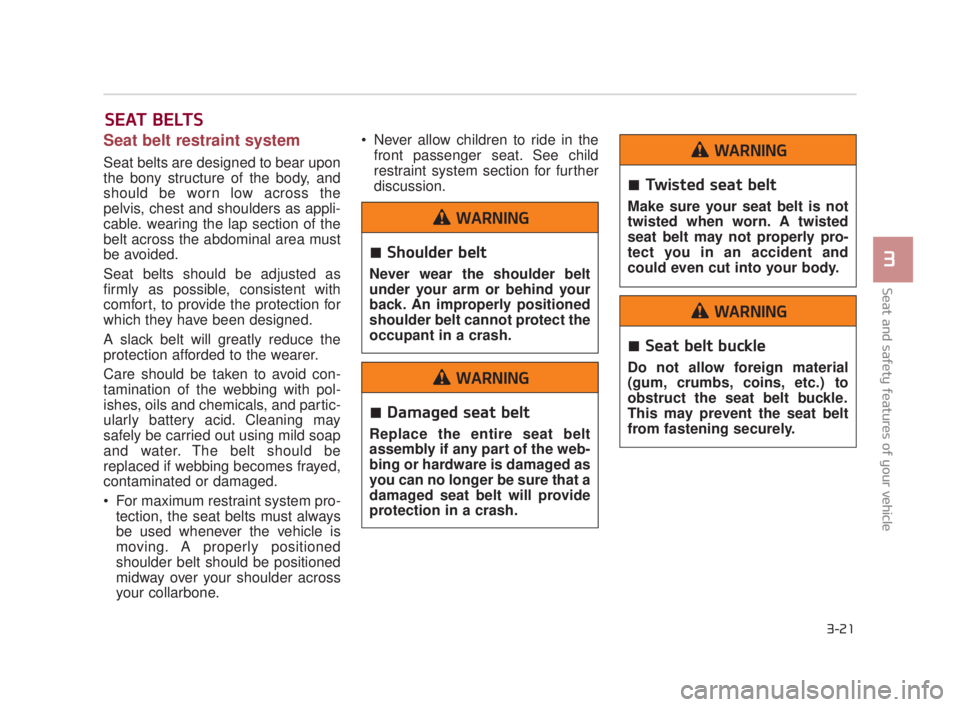
Seat and safety features of your vehicle
3
3-21
Seat belt restraint system
Seat belts are designed to bear upon
the bony structure of the body, and
should be worn low across the
pelvis, chest and shoulders as appli-
cable. wearing the lap section of the
belt across the abdominal area must
be avoided.
Seat belts should be adjusted as
firmly as possible, consistent with
comfort, to provide the protection for
which they have been designed.
A slack belt will greatly reduce the
protection afforded to the wearer.
Care should be taken to avoid con-
tamination of the webbing with pol-
ishes, oils and chemicals, and partic-
ularly battery acid. Cleaning may
safely be carried out using mild soap
and water. The belt should be
replaced if webbing becomes frayed,
contaminated or damaged.
For maximum restraint system pro-tection, the seat belts must always
be used whenever the vehicle is
moving. A properly positioned
shoulder belt should be positioned
midway over your shoulder across
your collarbone. Never allow children to ride in the
front passenger seat. See child
restraint system section for further
discussion.
SEAT BELTS
Shoulder belt
Never wear the shoulder belt
under your arm or behind your
back. An improperly positioned
shoulder belt cannot protect the
occupant in a crash.
WARNING
Damaged seat belt
Replace the entire seat belt
assembly if any part of the web-
bing or hardware is damaged as
you can no longer be sure that a
damaged seat belt will provide
protection in a crash.
WARNING
Twisted seat belt
Make sure your seat belt is not
twisted when worn. A twisted
seat belt may not properly pro-
tect you in an accident and
could even cut into your body.
WARNING
Seat belt buckle
Do not allow foreign material
(gum, crumbs, coins, etc.) to
obstruct the seat belt buckle.
This may prevent the seat belt
from fastening securely.
WARNING
KH USA 3:2018 4/18/2017 9:34 AM Page 21
Page 43 of 544
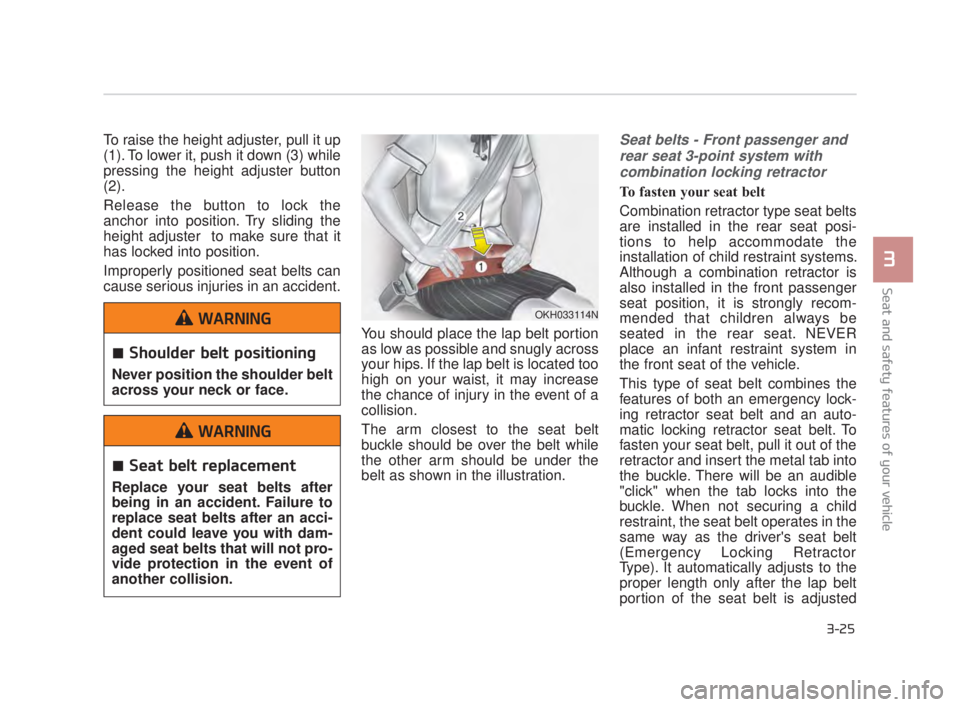
Seat and safety features of your vehicle
3
3-25
To raise the height adjuster, pull it up
(1). To lower it, push it down (3) while
pressing the height adjuster button
(2).
Release the button to lock the
anchor into position. Try sliding the
height adjuster to make sure that it
has locked into position.
Improperly positioned seat belts can
cause serious injuries in an accident.You should place the lap belt portion
as low as possible and snugly across
your hips. If the lap belt is located too
high on your waist, it may increase
the chance of injury in the event of a
collision.
The arm closest to the seat belt
buckle should be over the belt while
the other arm should be under the
belt as shown in the illustration.Seat belts - Front passenger andrear seat 3-point system withcombination locking retractor
To fasten your seat belt
Combination retractor type seat belts
are installed in the rear seat posi-
tions to help accommodate the
installation of child restraint systems.
Although a combination retractor is
also installed in the front passenger
seat position, it is strongly recom-
mended that children always be
seated in the rear seat. NEVER
place an infant restraint system in
the front seat of the vehicle.
This type of seat belt combines the
features of both an emergency lock-
ing retractor seat belt and an auto-
matic locking retractor seat belt. To
fasten your seat belt, pull it out of the
retractor and insert the metal tab into
the buckle. There will be an audible
"click" when the tab locks into the
buckle. When not securing a child
restraint, the seat belt operates in the
same way as the driver's seat belt
(Emergency Locking Retractor
Type). It automatically adjusts to the
proper length only after the lap belt
portion of the seat belt is adjusted
OKH033114N
Shoulder belt positioning
Never position the shoulder belt
across your neck or face.
WARNING
Seat belt replacement
Replace your seat belts after
being in an accident. Failure to
replace seat belts after an acci-
dent could leave you with dam-
aged seat belts that will not pro-
vide protection in the event of
another collision.
WARNING
KH USA 3:2018 4/18/2017 9:35 AM Page 25
Page 44 of 544
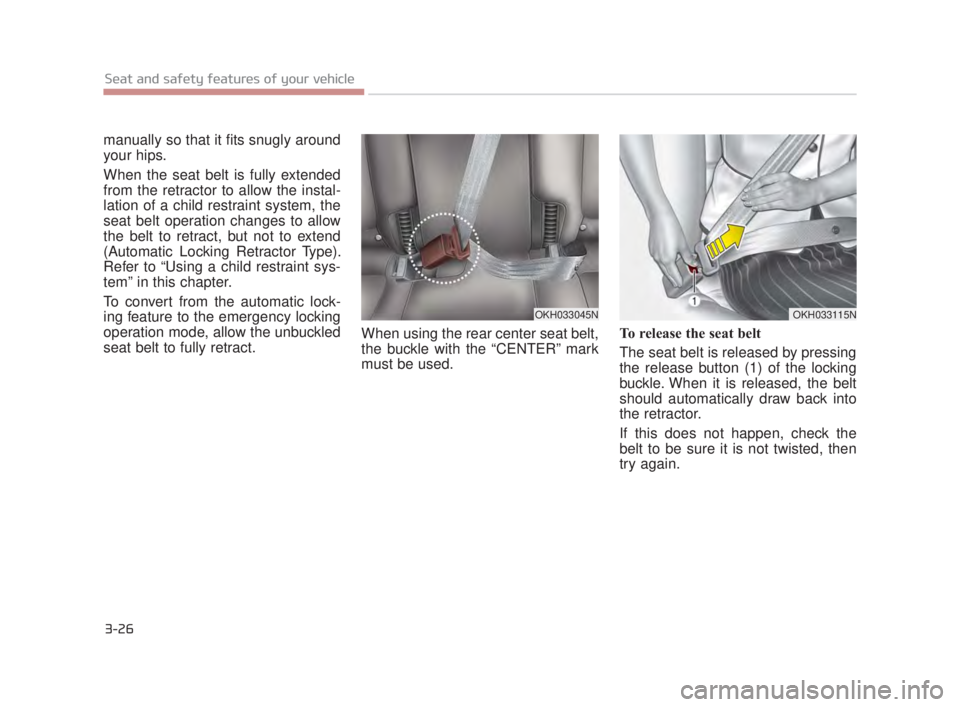
3-26
Seat and safety features of your vehicle
manually so that it fits snugly around
your hips.
When the seat belt is fully extended
from the retractor to allow the instal-
lation of a child restraint system, the
seat belt operation changes to allow
the belt to retract, but not to extend
(Automatic Locking Retractor Type).
Refer to “Using a child restraint sys-
tem” in this chapter.
To convert from the automatic lock-
ing feature to the emergency locking
operation mode, allow the unbuckled
seat belt to fully retract.When using the rear center seat belt,
the buckle with the “CENTER” mark
must be used.To release the seat belt
The seat belt is released by pressing
the release button (1) of the locking
buckle. When it is released, the belt
should automatically draw back into
the retractor.
If this does not happen, check the
belt to be sure it is not twisted, then
try again.
OKH033115NOKH033045N
KH USA 3:2018 4/18/2017 9:35 AM Page 26
Page 48 of 544
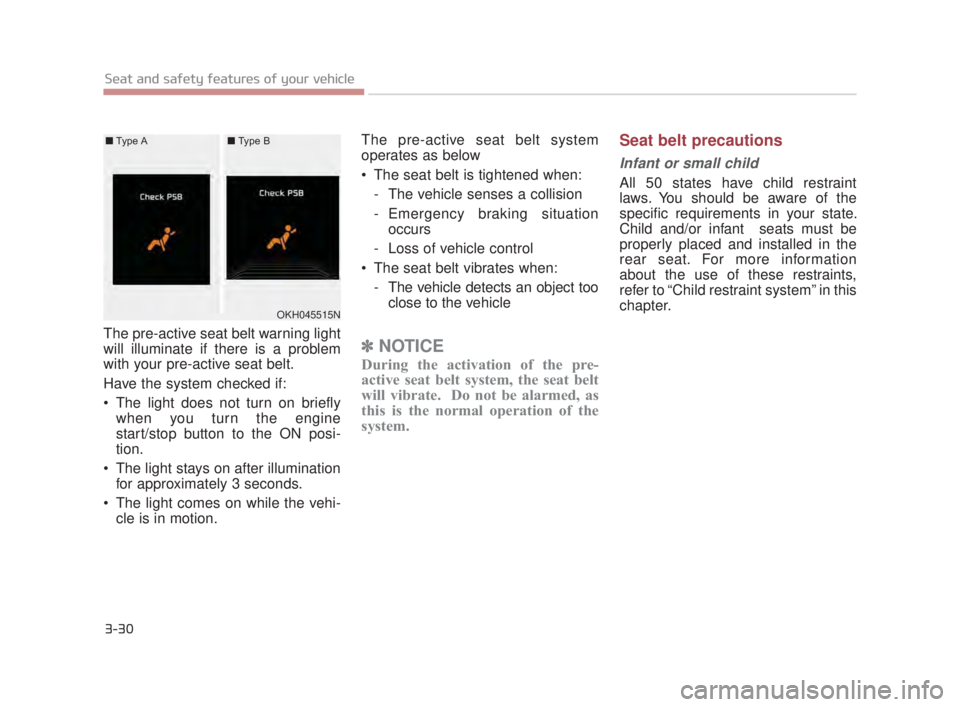
3-30
Seat and safety features of your vehicle
The pre-active seat belt warning light
will illuminate if there is a problem
with your pre-active seat belt.
Have the system checked if:
The light does not turn on brieflywhen you turn the engine
start/stop button to the ON posi-
tion.
The light stays on after illumination for approximately 3 seconds.
The light comes on while the vehi- cle is in motion. The pre-active seat belt system
operates as below
The seat belt is tightened when:
- The vehicle senses a collision
- Emergency braking situation occurs
- Loss of vehicle control
The seat belt vibrates when: - The vehicle detects an object too close to the vehicle✽ NOTICE
During the activation of the pre-
active seat belt system, the seat belt
will vibrate. Do not be alarmed, as
this is the normal operation of the
system.
Seat belt precautions
Infant or small child
All 50 states have child restraint
laws. You should be aware of the
specific requirements in your state.
Child and/or infant seats must be
properly placed and installed in the
rear seat. For more information
about the use of these restraints,
refer to “Child restraint system” in this
chapter.
OKH045515N
■ Type A■Type B
KH USA 3:2018 4/18/2017 9:35 AM Page 30